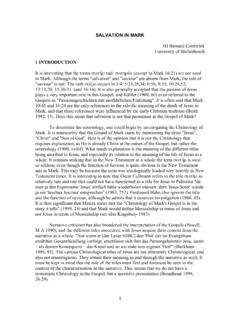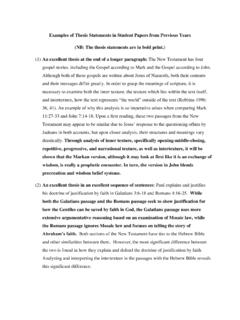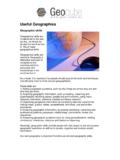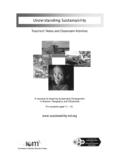Transcription of Nota Bene-- C: bwinDOCUMENTJohn GospelSawyer …
1 Eyes wide open, seeing nothingThe challenge of the Gospel of John s non-vizualizable texture for readings using visual textureL. Gregory BloomquistSaint Paul UniversityFaculty of TheologyIntroductionI d like you to visualize God. If you are able to do so, your visualization of God is probably drawn from images that you have seen of God. These images themselves are drawn from various sources: stained glass windows, statuary, children s Bibles, shrines, stories that you have heard. You may imagine a patriarchal style God with long beard, a multi-armed God fighting with a sword in each of many hands, a triangle with an eye, etc.
2 The task I assigned you is probably much harder if you are Jewish or Muslim, but it is not impossible. You might envision a fire, or an opening in the clouds. Or, you might be able to visualize the name of God written in calligraphic letters. But the aniconism of both religions probably leaves you unable to undertake the task. Next I d like you to visualize life. Not a particular form of life, like a lily, or a monkey, or your friend sitting next to you. I want you to envision life itself. Can you do it? If you can, it is probably a rushed mixture of all sorts of specific and generic images all blended , I d like you to visualize light.
3 Again, not a particular form of light, like a light bulb, or the sun streaming through the window, nor even the source of light, like a campfire at night or the sun by day. I want you to envision light itself. Can you do it? If you can, it is probably a blinding whiteness, which we know is what we see when our eye sees all of the wavelengths of the visible spectrum in a rushed mixture of them all together, at full brightness and without absorption .1 Finally, and most difficult of all, I want you to visualize reason.
4 What do you see? You might see a woman frowning, deep in thought. You might see in your mind what you imagine to be an fMRI scan, with the computerized depiction of increased oxygen flow in the prefrontal lobe. But, these are all reflections in your mind of visualizations of humans engaged in a process that involves reason and much else. But, can you visualize reason itself?Or, if instead of trying to visualize reason, I asked you to visualize speech? Not speaking. That would be relatively straightforward: you would picture a man or woman s mouth in the process of uttering something, be it intelligible to you or not.
5 Can you visualize speech itself? Unless you have the unusual ability that some people may have to see sound-waves, my guess is that you find this challenge as difficult as trying to visualize opening verses of John s Gospel, verses that many of us consider to be of such lofty poetic expression that they rank among the few passages in the New Testament that we consider worthy of great literature, verses that many Christians associate with the second greatest feast of the Christian year, Christmas, when these verses are annually read aloud around the world , set before the hearer these very same the beginning was the Word, and the Word was with God, and the Word was God.
6 2 He was in the beginning with God. 3 All things came into being through him, and without him not one thing came into being. What has come into being 4 in him was life, and the life was the light of all people. 5 The light shines in the darkness, and the darkness did not overcome it. (John 1:1-5 NRS)God, life, light. Word , which in Greek, means reason or speech . And note, one could have pushed this even further. Can you visualize the beginning? That time before which something existed? How about all things , or being , or even darkness.
7 2 1. , perhaps darkness is the one thing that you can visualize because when you close your eyes, you see nothing, not even light . It is the absence of everything that can be visualized and strikingly, that, we can kind of visualize. With that one exception, to which I will return, can anything of these opening few verses of John s Gospel be visualized?
8 What is the purpose of setting before you tasks that seem destined to fail? Surely, this is poor reason is a very simple even if you cannot immediately visualize it. It is this. If Vernon Robbins is correct in his assertion that rhetorical address relies primarily though not exclusively on the use of images that are set before hearers,2 and that where one is set up for the scenario that these images displays is at the start of a text, then the Gospel of John in its opening words presents its hearers with an impossible task and may be off to a failed start.
9 An alternative is that Robbins s assertion is , we are talking about a Gospel in which seeing or sight is considered to be one of the main actions or themes of the entire Gospel. There is no other New Testament text in which the theme of seeing and vision , or ironic inversions of the notion of vision , are as central. It is a Gospel that hinges as no other canonical Gospel does on what the reader sees, and this according to the Gospel , John s Gospel stands as an important test case for Robbins s assertion. It is a text that requires that we probe Robbins s assertion more fully and gives us an excellent, though in the end paradoxically satisfying, opportunity to do so.
10 Sociorhetorical interpretation and rhetographySociorhetorical analysis or interpretation (henceforth SRI), as developed by Vernon Robbins, is itself a development of classical and modern rhetoric. Drawing on both, as well as the tools made available to us in social and cultural studies, SRI is an attempt to get at the strategies by which humans communicate in full-bodied ways, , in the context of lived experience. It is a form of rhetorical analysis 3 2.








